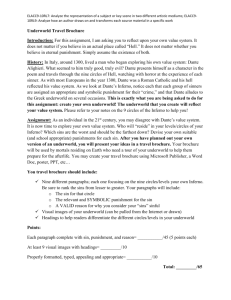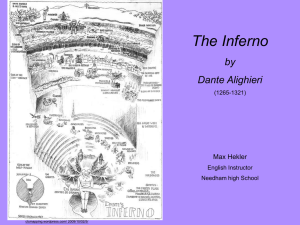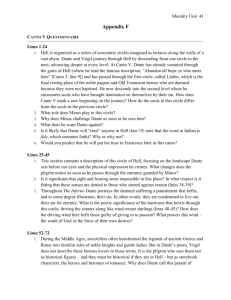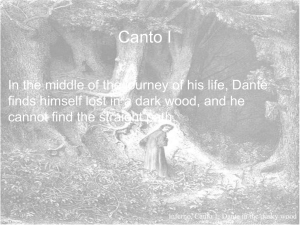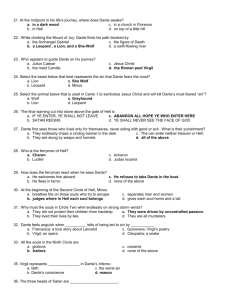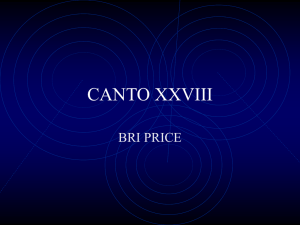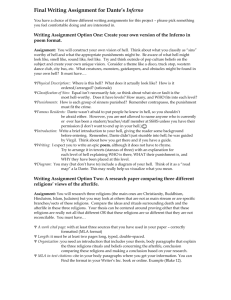The Aeneid and The Inferno: Social Evolution
advertisement
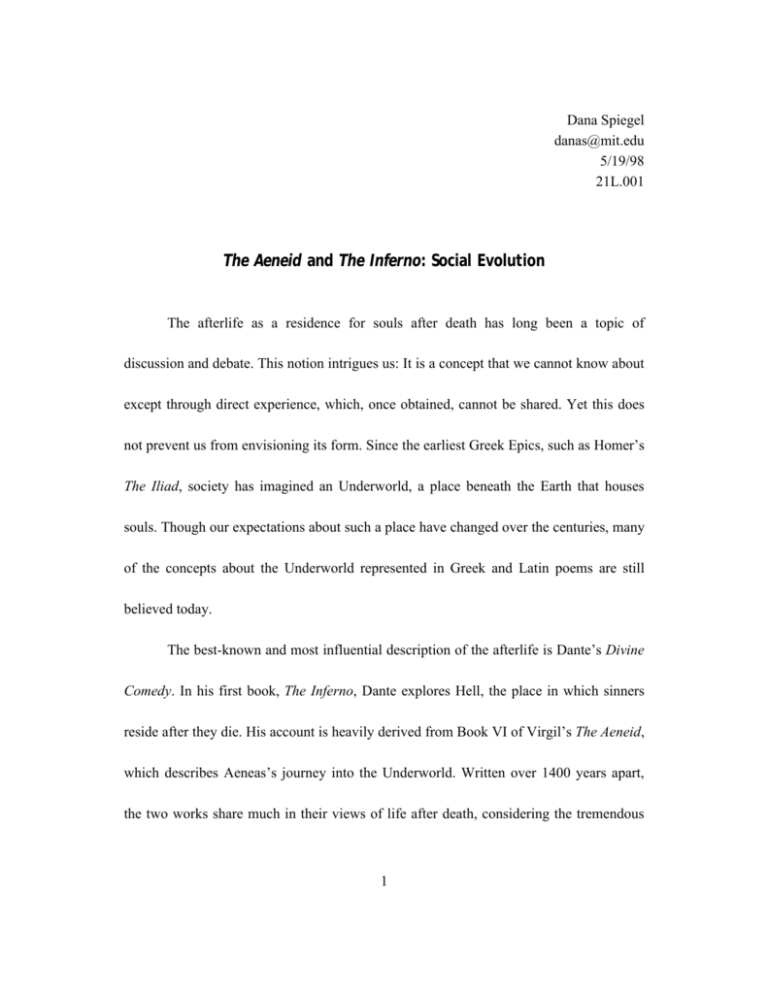
Dana Spiegel danas@mit.edu 5/19/98 21L.001 The Aeneid and The Inferno: Social Evolution The afterlife as a residence for souls after death has long been a topic of discussion and debate. This notion intrigues us: It is a concept that we cannot know about except through direct experience, which, once obtained, cannot be shared. Yet this does not prevent us from envisioning its form. Since the earliest Greek Epics, such as Homer’s The Iliad, society has imagined an Underworld, a place beneath the Earth that houses souls. Though our expectations about such a place have changed over the centuries, many of the concepts about the Underworld represented in Greek and Latin poems are still believed today. The best-known and most influential description of the afterlife is Dante’s Divine Comedy. In his first book, The Inferno, Dante explores Hell, the place in which sinners reside after they die. His account is heavily derived from Book VI of Virgil’s The Aeneid, which describes Aeneas’s journey into the Underworld. Written over 1400 years apart, the two works share much in their views of life after death, considering the tremendous 1 changes society had gone through during the interim. The differences in their portrayals of the Underworld point to fundamental differences in society’s beliefs about the afterlife during those periods. By comparing and contrasting the depictions of the Underworld, we can examine the evolution of pre-Christian Latin society into the Christian society of the Middle Ages. We can further comment on society’s changing views of sin and evil behavior, and their punishment in the afterlife. The similarity between Dante’s The Inferno and Book VI of Virgil’s The Aeneid is, in many cases, clear. Both stories are written as Epic journeys. The Aeneid follows the journey of Aeneas from a sacked Troy to Italy, where he begins a new life and starts to build a new city for the homeless Trojans. The Inferno follows Dante (a character in his own book) as he journeys through Hell. Virgil and Dante often invoke the Muses to help them in the telling of their stories—a classic Epic device. Both Dante’s journey (taken as the complete passage through both Heaven and Hell in the Divine Comedy) and Aeneas’s follow Joseph Campbell’s model—separation, trial, victory, return, and reintegration—of the archetypal hero journey.1 Although Dante’s hero status, unlike Aeneas’s, is not 1 Spiegel, Dana. “The Odyssey as a Psychological Hero Journey.” 1998 (unpublished). This paper discusses the framework of Campbell’s Hero Journey using Homer’s The Odyssey as an example. 2 clearly presented, his successful passage through Hell is a feat any of his contemporaries would hail as hero worthy. Looking at the journeys themselves, we again see certain similarities. Both Dante and Aeneas are led through the Underworld—Aeneas by the Sybil, a mortal given godlike powers by Zeus, and Dante by Virgil, the ghost of the Latin poet. (By making Virgil a character in his book, Dante acknowledges the derivative nature of his own work.) In both cases, the guides are more powerful, within their domain, than the men they are leading. In The Inferno, we often see Virgil confront the demons of Hell while Dante hides in fear. Similarly, the Sybil shows no fear when dealing with the keepers of the Underworld. When threatened by Charon for trying to break the “eternal law” that no living being should enter the Underworld, she retorts: Here are no such plots, So fret no more. These weapons threaten nothing. Let the great watchdog at the door howl on Forever terrifying the bloodless shades. Let chaste Proserpina remain at home In her uncle’s house. The man of Troy, Aeneas, Remarkable for loyalty, great in arms, Goes through the deepest shades of Erebus To see his father. 3 If the very image of so much goodness moves you not at all, Here is a bough”2 While on their journeys, both Aeneas and Dante meet contemporaries, with whom they talk, as well as famous historical figures. Aeneas, upon meeting Deïphobus, asks the officer about his mutilated appearance.3 Dante expands on Virgil’s idea of questioning the dead to find out what brought them to their current state. Encountering the Jovial Friars in the Eighth Circle of Hell, Dante asks “who are you, who bear / Upon your cheeks these distillate of woe? / What is your punishments that glitters so bright?” In response, one of the Jovial Friars says, “The orange cloaks are lead…/ So thick, that we their scales creak at the weight.”4 Both Aeneas and Dante are limited in the amount of time that they may spend in the Underworld. Aeneas has only an “allotted time” to spend, and the Sybil is adamant about keeping to their course: “Night comes on, Aeneas, / We use up hours grieving.”5 2 Virgil. The Aeneid. Book VI. ll. 537-548. Ibid. ll. 671-682. 4 Dante. The Inferno. Canto XXIII. ll. 93-96. 5 Virgil. ll. 720-724. 3 4 Virgil keeps Dante on track as well, ensuring they do not waste time speaking to one person and miss seeing parts of Hell because of their time constraints. Looking at the structure of the Underworld, we see differences between Virgil and Dante’s portrayals. Both propose that the Underworld has a certain logical structure, where souls are separated based on their defining actions while alive. Virgil, while separating good, evil, and ethically neutral people, defines no set boundaries for the souls within each of these broad categories. Dante keeps a similar structure, placing sinners in Hell and keeping good people separate. Dante’s Hell, however, is more well-defined, with land barriers separating the different circles. This absolute separation of sinners in Hell is a result of the religious views of Dante’s time. The Christian Church, which was a powerful social force during the Middle Ages, had a much sterner outlook on the afterlife than did Virgil’s society. A person’s inability to escape his fate in Hell made acting in sin more undesirable. This view was not lost on the Church, which used it as a way to scare the faithful into acting ethically. Dante’s notion of Limbo is markedly different from Virgil’s. For Virgil, Limbo was the first place souls stopped on their way to the Underworld. To move forward from 5 Limbo, your body had to be buried, or you had to walk the shores of Cocytus for a hundred years.6 Dante instead places virtuous pre-Christian-era souls in Limbo, forcing those of the Christian era into either Heaven or Hell. The influence of the church is clearly present. If a person doesn’t believe in God as presented by the Church, he is considered a sinner and is forced to go to Hell. Virgil had no religious prejudice, and as a result the placement of souls in his Underworld is blind to people’s beliefs. The segmentation of Hell in The Inferno points to a further influence by the Church. Each of Dante’s Circles houses souls based upon their sin, grouped generally into sins of incontinence, violence, fraud, and betrayal. He subdivides these general categories into sections that map (generally) to the seven deadly sins: gluttony, wrath, sloth, avarice, lust, envy, and pride. Dante further ranks each of the sins based on their evil properties: the closer to the center of Hell a soul resides, the more evil their sin. Virgil does not rank the places in the Underworld based on the metric of sin—although those souls in Hell are there because of violations of his society’s older code of ethics: cheaters, hoarders, adulterers, and betrayers.7 These categories are the forebears of those 6 7 Ibid. ll. 436-447. Ibid. ll. 813-820. 6 used by Dante to divide his Hell. As society changed, ethical standards changed as well, and the expectations of the type of person who would reside in Hell after death likewise changed, as can be seen by these categorizations. Virgil and his society believed that no one behaved perfectly throughout life; no one was without sin. Every soul that entered the Underworld had to pay dues: Not all the scourges of the body pass From the poor souls, not all distress of life. Inevitably, many malformations, Growing together in mysterious ways, Become inveterate. Therefore they undergo The discipline of punishments and pay In penance for old sins… We suffer each his own shade. Dante’s Hell is far more unforgiving. If a person has sinned and has not repented in life, his soul is placed in Hell, doomed to suffer for eternity without hope of ever escaping, regardless of dues paid. This notion of eternal suffering is unique to Dante’s Hell (and the Christian beliefs it represents). The souls in Virgil’s Underworld, “When they have turned Time’s wheel a thousand years, / The god calls in a crowd to Lethe stream, / That 7 there unmemoried they may see again / The heavens and wish re-entry into bodies.”8 Virgil’s contemporaries believed that souls were reincarnated, so whatever suffering was endured in Hell, it would last at most a thousand years. The suffering endured by the sinners in Virgil’s Hell is not well described. He does give some indication of the punishments endured: “Some heave at a great boulder, or revolve, / Spreadeagled, hung on wheel-spokes.”9 For Virgil, the exact nature of a doomed soul’s suffering is not important; the mere existence of that suffering is enough to make Hell an undesirable place. Dante takes the notion of physical suffering one step further by presenting the notion of Contrapasso—suffering based on the sin committed. This is clearly a worse fate for souls who have committed worse sins. People are deterred from committing more grievous sins since their punishment will be that much worse. Contrapasso also fits well with Dante’s segmentation and ranking of sins: If a sin is worse, its punishment is worse. Further, the punishment is specifically directed towards that quality of a person that is sinful. 8 9 Ibid. ll. 1005-1008. Ibid. ll. 824-825. 8 It is clear that the two Underworlds envisioned in The Aeneid and The Inferno are similar. Virgil presents a Hell based on his society’s beliefs about the afterlife. In Virgil’s Underworld, everyone suffers his due; his belief that no one acts perfectly during life requires this. Once a soul’s suffering is complete, and he is cleansed, he may live the rest of the thousand years with others that have been similarly cleansed. Dante takes many of these ideas and augments them with the beliefs of his time, creating a Hell that is specific to his society’s ethics and beliefs. For Dante, sin was any number of well-defined acts that could be repented while a person is still alive. Once he dies, a person is doomed to suffer eternally for his sins. This is the Christian belief about the afterlife, and the Church’s influence on Dante is clear. The transition from Virgil’s to Dante’s view of the Underworld reflects the social evolution from Augustus’ reign in Italy to Italy’s Middle Ages. 9

